| Online: | |
| Visits: | |
| Stories: |
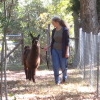
| Story Views | |
| Now: | |
| Last Hour: | |
| Last 24 Hours: | |
| Total: | |
Second Hive Check
Two of my questions as a novice Warré beekeeper were how long to feed my hive of package bees, and when to add more hive boxes.
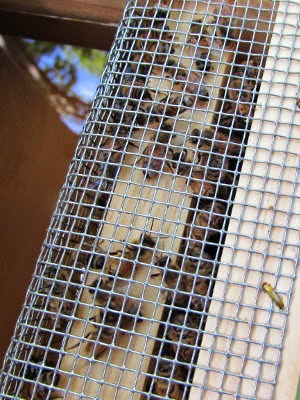 |
| Honeybees in my hive top feeder |
In his video tutorial, “About Hivetop Feeders“, Chris Harvey of The Warré Store (where I purchased my feeder) says to feed them until the first hive box is entirely filled with comb. In The Backyard Beekeeper Kim Flottum says to feed them as long as they'll consume it. This check was to see how far along they were in building comb in the top hive box.
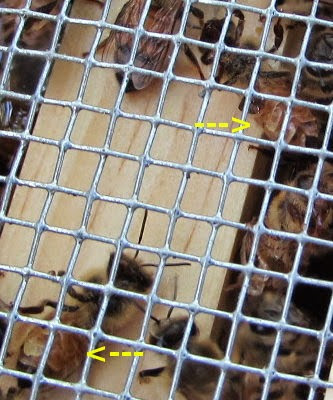 |
| If you look closely at the bees I've arrowed, you'll see scales of wax being secreted from glands on their abdomens. |
Dan and I lit the bee smoker, removed the top, quilt, and feeder, and took a look.
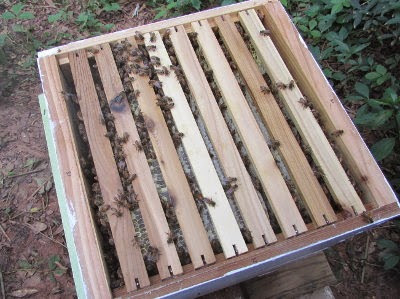 |
| This time I had the camera! |
The first thing I noticed was that they were drawing comb along the wax beads I painted on the top bars. That was good news because it will make it easier to remove individual bars of comb if needed. Sometimes they attach comb to two or more of the top bars, making it impossible to remove only one. This is known as crosscombing.
I also noticed that some of the comb is already capped, some cells aren't, and that some of the top bars had not been drawn out yet.
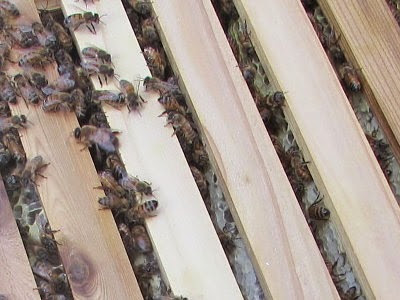 |
| Busy bees at work |
I did not look for the queen or brood. I'm trusting that my hive is queenright (has a healthy queen) by the bees' behavior. They are busy, purposeful, and bringing in quite a bit of pollen. Pollen is necessary for initially feeding brood, which takes 21 days from egg to emerging adult bee.
They had emptied the feeder so I put it back on the hive and added more. I'm using a 1:1 sugar syrup with a tablespoon of homemade honey-bee-healthy added to each quart.
How will I know when to add another hive box? According to David Heaf in his Natural Beekeeping with the Warré Hive, boxes are nadired (added to the bottom) when the bottom box is about 1/2 built with comb. How will I know that? With a handheld mirror. The idea is to add more boxes before they fill up the available space and decide to swarm in search of a larger home.
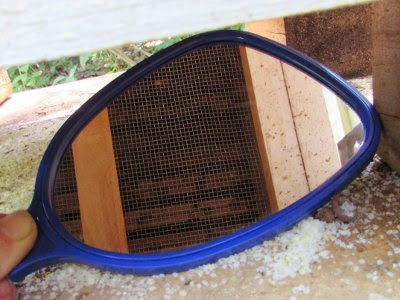 |
| Checking progress. We're looking up through the screened bottom at the top bars in the bottom box. Bees are present but not yet drawing comb. |
That's where a screened bottom comes in handy. When I first took a peek about a week and a half ago, I saw no bees in the mirror. Now I see them because comb-building has progressed so that bees are in the area. Once they fill up that top box they'll start building comb in the next box down. The queen will move down as well, to lay eggs in the new comb. The cells vacated by newly emerged bees will be filled with honey.
About a week ago I enlarged the hive opening a bit.
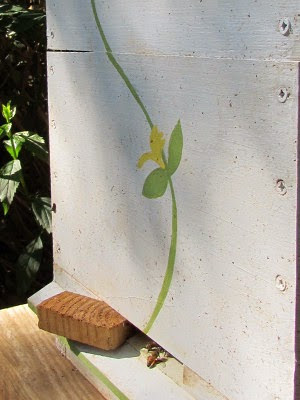 |
| Traffic is lightest in morning and evening, heaviest in the afternoon. |
Traffic was bottle-necking at the entrance so I swapped out the little chunk of wood to accommodate them. The purpose of narrowing the entrance is to give the new hive a better chance to defend itself, until the bees build up better numbers. Shortly after that I observed a carpenter bee trying to gain entrance. It was not only repelled but literally kicked out on its butt! Much to my relief it gave up after that.
They are certainly busy during the day, bringing in pollen, nectar, and water. I've only had the hive for about three weeks now, so the first of the brood ought to be hatching. These will take up house bee duties for their first several weeks of life, allowing the older bees to enter the foraging ranks. Some time I'll have to write a post about the life stages of a honeybee, because of all of God's creatures, I think they are the most fascinating.
Source: http://www.5acresandadream.com/2015/05/second-hive-check.html



